#at the Roman Forum. Rome's main street
Explore tagged Tumblr posts
Text

#Remains of capitals#entablature and pediment. Temple of Saturn#at the Roman Forum. Rome's main street#the Via Sacra#passes under it and crosses the whole Forum down to the Colosseum. The ruins belong to the 3rd phase of the Temple of Saturn#built after a fire around 360 AD...
0 notes
Text
Some Roman Art Vocabulary

for your next poem/story
Acanthus - a kind of Mediterranean plant with large spreading leaves. It was used as a decorative element on Corinthian capitals and also was a symbol of death.
Amphitheater - an elliptical structure with a central arena for the staging of gladiatorial contests and animal combats.
Apse - a semicircular space within a Roman building. Typically a basilica would have an apse at one end.
Arch - a curved architectural member that spans an opening.
Atrium - the central room of a Roman house. It had a hole in the ceiling and a pool in the center of the floor to catch rainwater.
Aureus - the most valuable Roman coin, made of gold.
Barrel vault - a semicircular ceiling over parallel walls.
Basilica - a building type used for law courts and conducting business, which usually stood in the town forum. It consisted of a long rectangular hall with an apse at one end and three aisles separated by columns. The central aisle had a raised ceiling and clerestory windows. Often the exterior of the building was colonnaded.
Cameo - a relief carved from a stone that has layers of different colors, such as sardonyx.
Capitolium - the main temple for civic worship in Rome and other cities. It was dedicated to the three chief gods, Jupiter, Juno, and Minerva.
Cardo - the name of the north-south street in a Roman town laid out on the grid system.
Cavea - the rounded space of a theater containing seats for the spectators.
Colonnade - a row of columns.
Columbarium - a type of communal building to hold ash urns of the cremated. The name comes from the structure’s resemblance to a dovecote, since the urns, as well as portrait busts, were placed in niches in the walls similar to the nesting spaces in such a birdhouse.
Column - a weight-bearing architectural member that has a base, a cylindrical shaft, and a capital (ornamental top).
Concrete - a building material made of small stones or rubble (aggregate), lime mortar, water, and volcanic sand (pozzolana).
Consuls - the two chief magistrates of the Roman state, elected annually.
Cubiculum - the bedroom of a Roman house.
Damnatio memoriae - a decree by the senate that condemned an emperor and ordered that all images of him and references to him be obliterated.
Decumanus - the principal east-west street of a Roman town laid out on the grid system.
Source ⚜ More: Word Lists
#roman art#terminology#writing inspiration#writeblr#writing reference#dark academia#spilled ink#light academia#creative writing#literature#writers on tumblr#poets on tumblr#writing prompt#poetry#art vocab#writing resources
79 notes
·
View notes
Text

Rome is Building an Eight-Story Underground Museum – But Treasures Keep Getting in the way
Rome, as it’s often said, wasn’t built in a day. And nowhere is that more evident than its state-of-the-art Metro Line C, an ambitious project meant to help relieve the Italian capital’s renowned traffic hellscape and celebrate its rich archeological history with a unique-in-the-world underground museum.
The €700 million line ($757.7 million) was originally envisioned for the Catholic Jubilee of 2000 as a vital link between Rome’s San Giovanni Cathedral and Vatican City’s St. Peter’s Basilica, making it easier for visiting pilgrims to collect indulgences by walking through the churches’ holy doors. Rome’s major basilicas open their holy doors only during Jubilee years, allowing Catholics from all over the world to make pilgrimages to the city to walk through them, symbolizing an openness to receive mercy and reconciliation.

But the 2000 dream never happened, thanks to a series of problems ranging from a corruption scandal in the city government and the sheer number of archeological objects – 40,000 in all, from petrified peach pits to pottery and vases and even the walls and mosaics of Emperor Hadrian’s 2,000-year-old military barracks – found with each shovel full of dirt during the initial preparations.
Now the hope is to have the line’s showcase Piazza Venezia stop, featuring an eight-story underground museum, ready in 10 years, according to engineer Andrea Sciotti, who is in charge of the metro museum complex. This will allow them to open around the Jubilee of 2033, which will mark 2,000 years since the death of Jesus Christ.
“It’s true, 10 years seems like a long time, but we aren’t just dealing with the engineering issues,” Sciotti said inside the construction site. “This station will be judged as the most beautiful in the world … we don’t have to rely on museum items being brought in, the museum station is in its original context in ancient Rome.”
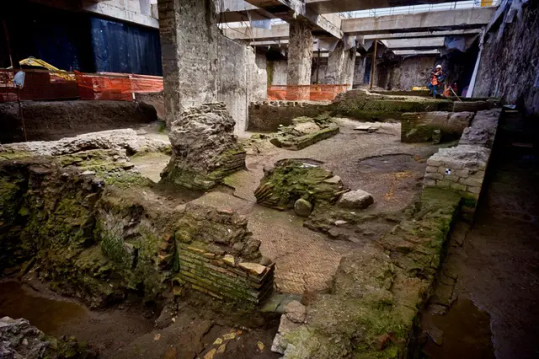
Displayed where they were found:
During the initial phases of work carried out in the last five years, Sciotti said all of the artifacts were removed from the site for restoration. Each will be placed exactly where it was found inside the metro museum, which is being dug some 85 meters (280 feet) deep, encompassing eight stories below the modern city of Rome.
Over the millennia the modern city has been built over covered ruins. Only around 10% of ancient Rome has been excavated, with the rest still buried some nine meters (30 feet) below the current city, according to Rome’s tourist bureau. The city dates back to the stone age and construction work is notoriously hampered by the discovery of ruins that are too plentiful to even excavate and are often reburied to preserve them. Even simple infrastructure work, like sewage repairs, have to be attended by archeologists who have the power to stop the work if something is found.
There will be 27 escalators, six elevators and 66,000 square meters of archeological exhibit space. Ancient walls found during excavations will be placed “in situ” in the modern station and the ancient Via Flaminia that ran through the ancient city to the nearby Roman Forum and Colosseum.
The station’s three main entrances will connect the three museums around the square: the Vittoriano, the Palazzo Venezia and the outdoor ruins of the Roman Forum anchored by the Colosseum at the far end, which has its own metro station that will also feature museum and exhibit space.
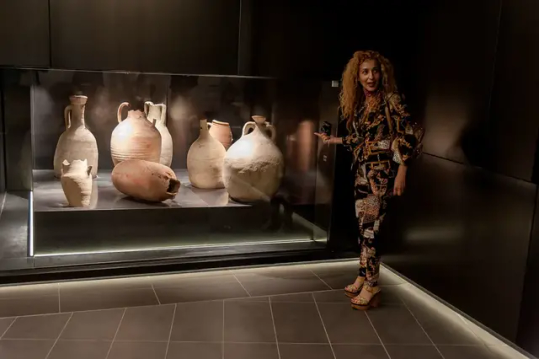
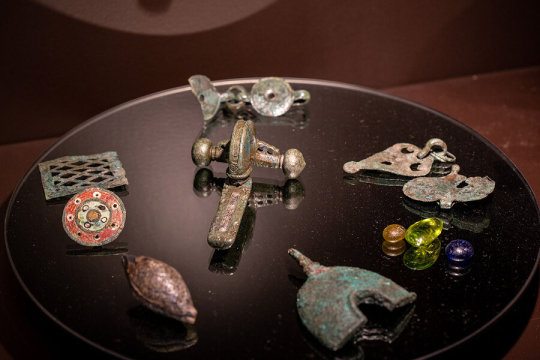
Several of the archeological sites will have access points from inside the metro museum, meaning commuters and tourists alike can exit the station by rambling through historically significant ruins like Hadrian’s Auditorium, which was discovered when the initial archeological investigation into the project started and was meant to be the location of the station entrance. Since then, they moved the site and excavated the ruins, which are currently only visible looking down from street level.
‘Top down’ excavation system:
To secure the site as they dig, engineers are using a “top down” excavation system, which has never been used in Italy but was an integral part of the Jubilee line in London. Cross walls and diaphragms are being buried deep into the soil to form the perimeter of the underground complex, with the dirt taken out recycled and enhanced to be used in the building materials, Sciotti said.
The train tunnels themselves are not the issue since they will be more than 100 feet below ground.

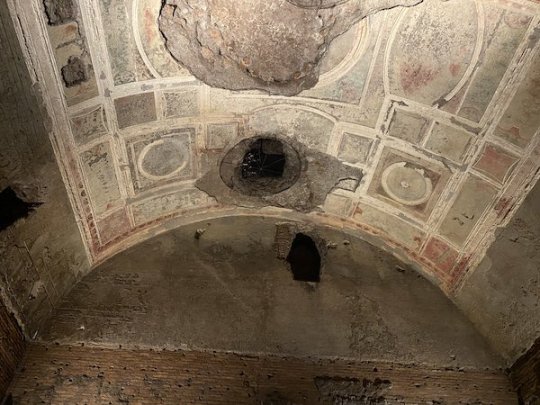
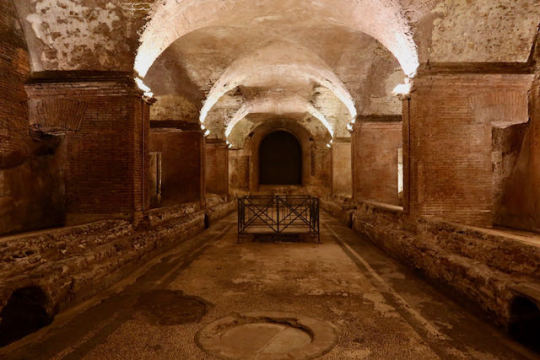
The Venezia station museum stop is not the only treasure on the new line. In 2016, archeologists working on the site of the Porta Metronia (previously known as the Ambra Aradam) station found a 39-room complex that spanned more than 9,700 square feet that has been incorporated into the underground station, which will open by the end of 2024. In 2025, the new Colosseo-Fori station, complete with a four-level underground museum to showcase artifacts including 25 archaic wells unearthed when it was built, will also open after activation tests, meant to begin in October, are completed.
The entire 26-kilometer C-line will be Italy’s first fully automated driver-less subway system and will reduce road traffic by 400,000 vehicles a day, meaning CO2 emissions will be reduced by some 310,000 tonnes a year, according to the WeBuild group, which is the main contractor for the project.
The original plans from the 2000 Jubilee have been modified to eliminate several stations in the historical center that would have simply been too difficult to excavate.
By Barbie Nadeau.

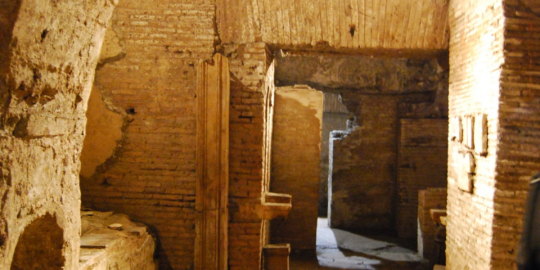

#Rome is Building an Eight-Story Underground Museum#The Venezia station museum#Metro Line C#Piazza Venezia stop#ancient artifacts#archeology#archeolgst#history#history news#ancient history#ancient culture#ancient civilizations#ancient rome#roman history#roman empire#roman art#ancient art#long post#long reads
121 notes
·
View notes
Note
Hi how are U? I was wondering if, when you have time, could write something on jannik sinner x Italian reader where she's a normal girl living in a little town in northern italy( not jannik's town) and they're not public due to jannik wanting to keep his private life discrete. Well, he surprises her at her place and she introduces him to her family, which he hasn't meet it yet despite teyrebeing together for a while.
I know it's very specific, but I hope you don't mind.
Thank u 💓
The Perfect Surprise
Pairing: Jannik Sinner x f!reader
category: fluff
warnings: none
Author’s Note: it turned out way different than I intended 🙈 but i hope you like it, lovely anon 🤗
* Y/N = your name
MY MASTERLIST

(via Instagram @ janniksin)
♦ - ♦ - ♦ - ♦ - ♦ - ♦ - ♦ - ♦ - ♦ - ♦ - ♦ - ♦ - ♦ - ♦ - ♦ - ♦ - ♦ - ♦ - ♦ - ♦ - ♦ - ♦
You miss him.
Last time you two saw each other was almost two months ago and although you know it’s the right decision to keep your relationship out of public it kinda hurts. Text messages, phone calls and video calls are just not enough.
You sigh and close the programs on your computer. Today’s workday dragged on even more than yesterday. And even though it's finally Friday, you can’t really enjoy getting off work early. In five hours, you're supposed to be at your grandparents' place, along with your parents and your two sisters - plus their boyfriends. Usually, you love spending time with your family, but seeing your sisters with their boyfriends makes you miss Jannik even more.
Jannik has been an important part of your life for almost a year now and every day you’re really grateful that you decided to take that trip to Rome for a few days of vacation a year ago. On the evening of the day you arrived, you decided to visit the Roman Forum and asked a young man to take a photo of you in front of the illuminated sight. Jannik said yes, and although the photo turned out to be amazing and the Roman Forum looked really impressive, you couldn't take your eyes off Jannik. You spent a lot of time together and the days ended with you and Jannik as a couple.
You’ve had long talks about how to handle it, and it was especially important for Jannik to keep your relationship private. It's the right decision, but it makes things difficult.
Yeah, you’d love to be by his side more often. Go to his tournaments and cheer for him. But most of all, you’d like to introduce him to your family and friends. Even though you've been together for almost a year now, there hasn’t really been a good opportunity for Jannik to meet your family - press events and injuries have gotten in the way so far.
“Have fun at your family dinner, Y/N,” your colleague waves at you with a smile, snapping you out of your thoughts. “Thanks, that’s nice of you!”, you wave back, pack your phone into your handbag, and leave the office quickly.
On one hand, it would be fun, but on the other hand, it would remind you that Jannik is missing. Your family knows you have a boyfriend and that he’s really busy, but they don’t know who he really is. Nicolò, your older sister’s boyfriend, would lean over to you with a grin again: “Are you sure your mysterious boyfriend is real? We’ve never seen him.” He doesn’t mean any harm, he’s just a jokester, but it still bothers you a lot.
Deep in thought, you push open the main entrance door of the office and step out onto the street. You work for a great company, right in your hometown. Since you know the way home by heart, you aren’t paying attention to your surroundings and jump in surprise when you suddenly hear someone calling your name.
You look up and suddenly think you must be hallucinating.
This can’t be real, it’s completely impossible.
"Jannik?" you ask, utterly confused as the tall young man with a bright smile walks towards you, "Is it really you?"
"Hi Y/N!" he beams at you, clearly amused by your disbelief.
"But...what...why...you’re supposed to be playing tennis!"
"Should I leave and go back to playing tennis?"
"NO!", you blurt out in shock, jumping towards him to hug him, "Oh my god, Jannik!"
The South Tyrolean laughs softly and wraps his arms around you too: "I’m glad my surprise worked!"
"Worked? I can’t believe it! Oh, I’m so happy!", you have to force yourself to let go of him - there are always curious eyes around.
Jannik looks at you with his bright eyes, his hands now in his pockets, his smile a bit forced: "I’ve got a few days off and came to see you as soon as I could."
You frown, "A few days off? Why?"
"My hip's acting up again..."
You feel your stomach tighten, "How bad is it?"
Jannik tilts his head from side to side, staring straight at the street. "Just bad enough to take a break from training."
That’s an understatement."
Your boyfriend presses his lips together and lowers his head: "Can’t we just be happy we get some time together?"
"Of course," you smile at him. You know how much Jannik’s recurring hip issues bother him, but this isn’t the right time or place to talk about it. When Jannik is ready to talk, you’ll be there. You’ll wrap your arms around him, rest your head on his shoulder, and he will tell you everything.
"I’d say we go home to my place and I cook us something nice...I went to the grocery store yesterday!" you suggest as you both start the short walk to your apartment. You resist the urge to reach for Jannik's hand and intertwine your fingers.
"That sounds like a great idea. Maybe we could try your grandma’s pasta sauce again? Last time we almost got it perfect and -"
Jannik's words make you stop in your tracks: "My grandma!", you exclaim, grimacing, "I still need to call my grandparents and parents to let them know I won't be coming to the family dinner!" You can already hear your grandma's disappointed words and see your dad's disapproving frown when you cancel.
Jannik looks at you curiously: "What family dinner?", he asks.
You let out a deep sigh: "My grandparents invited the whole family over for dinner tonight. I'll call and cancel as soon as we get home."
"But... aren't you excited about the family dinner?"
"Yeah, of course!", you nod immediately but then shrug, "But I'd rather spend time with you! I've missed you so much!"
Jannik doesn’t respond immediately, but you can see he’s deep in thought. After a few seconds, he finally speaks, his voice softer than usual. "We...we could go to your grandparents' together."
You think you’ve misheard and look at him in surprise. "What?"
A small smile appears on Jannik’s face. "I’d really like to meet your family, Y/N. I think it's long overdue."
Your entire family was, of course, absolutely thrilled with Jannik.
Later, your grandma would say: "Where have you been hiding this perfect son-in-law all this time?"
The family dinner went definitely differently than planned and so much better than you could have ever imagined.
Sitting among your family, laughing at one of your dad's terrible jokes, with Jannik's arm around your shoulders, was definitely the perfect evening.
♦ - ♦ - ♦ - ♦ - ♦ - ♦ - ♦ - ♦ - ♦ - ♦ - ♦ - ♦ - ♦ - ♦ - ♦ - ♦ - ♦ - ♦ - ♦ - ♦ - ♦ - ♦
tagging: @bluetackbaby @lxndonorris @fedalev @purplecloudarcade
#jannik sinner x reader#jannik sinner imagine#jannik sinner x you#jannik sinner#jannik sinner fanfic#jannik sinner fic#tennis imagine#tennis fic#tennis fanfic#tennis imagines#tennis fics#tennis fanfics#tennis fanfiction#tennis fanfictions#my writing#my imagine#mira's imagines
81 notes
·
View notes
Text
Living His Word

But thanks be to God, who always leads us as captives in Christ's triumphal procession and uses us to spread the aroma of the knowledge of him everywhere. — 2 Corinthians 2:14
In Roman times a general who had led an army to victory in battle would lead a triumphal procession down the main street of Rome. The purpose of the procession was to give Roman citizens the opportunity to celebrate the general and his victory. The procession would move from the outskirts of the city, past the Forum, and on to the Colosseum. The general would ride in a chariot at the head of the procession. At the rear of the procession would follow all the captives of the battle. Fragrant clouds of incense would be released into the air as the procession moved forward.
In our verse for today, the Apostle Paul uses certain aspects of this Roman celebration as an image to describe the meaning of life in Christ Jesus. There are three main aspects to this new life:
First, the new life is life led in triumphal procession by Jesus Christ himself. In Paul's view, Jesus is like a conquering general who has won a great battle. Due to the victory, life has been fundamentally altered for the better and the general is worthy of receiving great praise and honor. Life now consists of following the general in the procession of life and in the celebration of His triumph.
Second, the new life is life as a captive of Jesus Christ. Once we stood opposed to Jesus Christ as His enemies, but He has conquered us and made us captives in His triumphal procession. Captives of Christ are no longer enemies of Christ, however, but conquering allies of Christ. Unlike the Romans captives, who followed the general in abject humiliation and misery, we follow Jesus in joyous celebration of the conquest.
Finally, the new life is a life that spreads the "aroma" of Christ's victory everywhere. God uses Christ's captives to further the extent of the conquest. There are still enemies of Christ that exist outside the triumphal procession. God uses us to capture these enemies, release them from captivity to the flesh and the devil, and make them fellow captives of Christ.
We should be thankful to God for all this, because we have become part of Jesus Christ's conquest of sin and evil. We have become joyful participants in Christ's triumphal procession on the pathway of life.
© 2016 by Bible League International
4 notes
·
View notes
Text
Rome in a Day: Gladiators, Gelato, and the Ghosts of Emperors
Let’s be real: Rome is the ultimate time machine. One minute you’re dodging Vespas on cobblestone streets, the next you’re staring up at a 2,000-year-old stadium where gladiators fought to the death. Throw in a pope-approved city-state and gelato that’s basically edible art, and you’ve got a day that’s peak Roman chaos. Here’s how to live la dolce vita like a local (or a very enthusiastic tourist).
🏛️ The Colosseum: Where History Roars Start your morning here, early. Beat the crowds and let your imagination run wild. Stand in the arena where emperors once thumbed life-or-death decisions, and touch the same stones spectators climbed to watch chariot races and lion fights. Pro tip: The nearby Roman Forum is a free-for-all ruin playground—wander its crumbled temples and pretend you’re in a toga.
✝️ Vatican City: Saints, Sistine Secrets, and Staircases A 20-minute walk (or a chaotic tram ride) later, you’re in the world’s smallest country. The Vatican Museums are a maze of Renaissance bling, but the main event is Michelangelo’s Sistine Chapel. Stare at the ceiling until your neck cramps—it’s worth it. Don’t skip the spiral staircase (Instagram gold) or St. Peter’s Basilica, where the dome view will make you gasp louder than the pope during a bad homily.
🍦 Gelato-Fueled Streets: Sweet Survival Guide Rome’s heat hits different, so gelato is essential. Avoid neon-colored tourist traps—real gelato is muted, creamy, and sold at spots like Giolitti (since 1900) or Fatamorgana (wild flavors like basil-honey-nuts). Wander aimlessly with your cone, past fountains where locals toss coins and alleys strung with laundry. Sunset at the Spanish Steps? Perfect.
Verdict: Rome is messy, loud, and smells like espresso and ancient dust. But that’s the magic—it’s alive. You’re not just sightseeing; you’re crashing a 3,000-year-old party.
P.S. Wear comfy shoes. Trust me, Julius Caesar didn’t conquer Gaul in sandals.

0 notes
Text
Best Cities to Visit in Europe
Europe is a continent rich in history, culture, and breathtaking landscapes. Each city offers its unique charm and attractions. Here are some of the best cities to visit, each with its distinct personality and must-see sights.
1. Barcelona, Spain
Barcelona sightseeing, the vibrant capital of Catalonia, is famous for its unique blend of modernist and Gothic architecture. The city's most iconic landmark is the Sagrada Família, a basilica designed by the legendary architect Antoni Gaudí. Park Güell, another Gaudí masterpiece, offers stunning views over the city. Las Ramblas, a lively street lined with shops, cafes, and street performers, is perfect for a leisurely stroll. The Gothic Quarter, with its narrow medieval streets, is rich in history and charm. Barcelona's beaches, such as Barceloneta, provide a perfect place to relax.
2. Rome, Italy
Rome, the Eternal City, is a living museum. The Colosseum, an ancient amphitheater, is a symbol of Rome's grandeur. The Roman Forum and Palatine Hill offer a glimpse into the city's imperial past. Vatican City, home to St. Peter's Basilica and the Vatican Museums, including the Sistine Chapel, is a must-visit. The Trevi Fountain, where tradition says you should toss a coin to ensure your return to Rome sightseeing, and the Spanish Steps are also iconic landmarks. Rome's vibrant neighborhoods, such as Trastevere, offer authentic Italian dining and nightlife.
3. Florence, Italy
Florence, the cradle of the Renaissance, is renowned for its art and architecture. The Uffizi Gallery houses masterpieces by Michelangelo, Leonardo da Vinci, and Botticelli. The Florence Cathedral, with its iconic dome designed by Brunelleschi, dominates the city skyline. Ponte Vecchio, a medieval bridge lined with shops, offers picturesque views of the Arno River. The Palazzo Vecchio and the Boboli Gardens are also notable attractions. Florence's rich culinary tradition makes it a paradise for food lovers.
4. Seville, Spain
Seville, the capital of Andalusia, is known for its flamenco dancing, Moorish architecture, and vibrant festivals. The Seville Cathedral, the largest Gothic cathedral in the world, and the Giralda tower are must-see landmarks. The Alcázar of Seville, a royal palace with lush gardens, showcases Mudéjar architecture. Plaza de España, with its impressive Renaissance Revival architecture, is another highlight. Seville's lively neighborhoods, such as Santa Cruz, offer a taste of local culture and cuisine.
5. Edinburgh, Scotland
Places to visit in Edinburgh, the capital of Scotland, is a city of history and festivals. Edinburgh Castle, perched on an extinct volcano, offers stunning views of the city. The Royal Mile, stretching from the castle to the Palace of Holyroodhouse, is lined with historic buildings, shops, and pubs. The city's New Town, with its Georgian architecture, is a UNESCO World Heritage site. Edinburgh is also famous for its festivals, including the Edinburgh Festival Fringe, the world's largest arts festival.
6. Krakow, Poland
Krakow, one of Poland's oldest cities, is known for its well-preserved medieval core and Jewish quarter. The Main Market Square, one of the largest medieval squares in Europe, is home to the Cloth Hall and St. Mary's Basilica. Wawel Castle and Cathedral, perched on Wawel Hill, are symbols of Polish statehood. The Kazimierz district, the historic Jewish quarter, is rich in culture and history. Krakow is also a gateway to the Auschwitz-Birkenau concentration camp, a poignant reminder of the Holocaust.
7. Porto, Portugal
Porto, famous for its port wine, is a city of charming streets and vibrant culture. The Ribeira district, with its colorful houses and riverside cafes, is a UNESCO World Heritage site. The Dom Luís I Bridge offers panoramic views of the Douro River. The Livraria Lello, one of the most beautiful bookstores in the world, is a must-visit. Porto's wine cellars, where you can taste and learn about port wine, are also popular attractions.
8. Athens, Greece
Athens sights, the cradle of Western civilization, is a city where ancient history meets modern vibrancy. The Acropolis, with the Parthenon temple, dominates the skyline. The Acropolis Museum and the National Archaeological Museum offer a deep dive into Greek history. The Plaka neighborhood, with its narrow streets and neoclassical houses, is perfect for exploring. Syntagma Square, with the changing of the guard at the Hellenic Parliament, is a focal point of modern Athens.
9. Naples, Italy
Naples, a city with a rich history and vibrant street life, is the gateway to the Amalfi Coast and Pompeii. The historic center, a UNESCO World Heritage site, is filled with narrow streets, churches, and bustling markets. The Naples National Archaeological Museum houses an impressive collection of artifacts from Pompeii and Herculaneum. Naples is also famous for its pizza, and no visit is complete without trying an authentic Neapolitan pizza.
10. Venice, Italy
Venice city, the city of canals, is unlike any other place in the world. The Grand Canal, lined with Renaissance and Gothic palaces, is best explored by gondola. St. Mark's Basilica, with its stunning mosaics, and the adjacent Doge's Palace are must-see attractions. The Rialto Bridge offers iconic views of the canal. Venice's smaller canals and narrow alleys are perfect for getting lost and discovering hidden gems. The city's art and architecture, combined with its unique setting, make it a must-visit.
11. Amsterdam, Netherlands
Amsterdam tourist attractions, known for its picturesque canals and liberal culture, is a city of contrasts. The Anne Frank House, where Anne Frank wrote her diary during World War II, is a poignant historical site. The Van Gogh Museum and the Rijksmuseum, which houses works by Rembrandt and Vermeer, are must-visit for art lovers. The city's canals, best explored by boat or bike, offer a unique perspective. The Jordaan neighborhood, with its narrow streets and quaint cafes, is perfect for leisurely exploration.
12. Reykjavik, Iceland
Places to visit in Reykjavik, the capital of Iceland, is a gateway to some of the world's most stunning natural wonders. The Blue Lagoon, a geothermal spa, is a must-visit for relaxation. The Golden Circle route, which includes the Þingvellir National Park, Geysir geothermal area, and Gullfoss waterfall, is a popular day trip. Reykjavik itself offers a vibrant cultural scene, with numerous museums, galleries, and music venues. The Harpa Concert Hall, an architectural masterpiece, is a cultural hub of the city.
13. Paris, France
Paris sightseeing, the City of Light, is synonymous with romance, art, and culture. The Eiffel Tower, an enduring symbol of France, offers breathtaking views of the city. The Louvre Museum, home to the Mona Lisa and countless other masterpieces, is a must-visit for art enthusiasts. Notre-Dame Cathedral, despite the damage from the 2019 fire, remains a significant landmark. The Champs-Élysées, leading to the Arc de Triomphe, is perfect for a leisurely stroll and shopping. Montmartre, with its bohemian vibe and the Basilica of the Sacré-Cœur, is another highlight. Paris's café culture, charming neighborhoods, and exquisite cuisine make it an unforgettable destination.
0 notes
Text
Explore the Eternal City: Your Guide to Delhi to Rome Flights

Rome, often called the "Eternal City," is a place where history, culture, and modernity blend seamlessly. If you're planning a trip from Delhi to Rome, you're in for an unforgettable experience. This guide will walk you through everything you need to know about Delhi to Rome flights, making your journey smooth and enjoyable. Let's dive into the details!
Why Visit Rome?
Rome is a city like no other. It's a treasure trove of ancient history, art, and architecture. From the Colosseum to the Vatican, and the Pantheon to the charming streets of Trastevere, Rome offers something for every traveler. Whether you're interested in exploring historic sites, indulging in delicious Italian cuisine, or simply soaking in the vibrant atmosphere, Rome is a destination that promises a rich and memorable experience.
Choosing Your Flight
When planning your trip, one of the first steps is to book your flight. Here are some key points to consider for your Delhi to Rome flights:
Flight Duration: The flight from Delhi to Rome typically takes around 8 to 10 hours. This includes a direct flight time of approximately 8 hours, with some additional time for check-in and security procedures.
Airlines: Several airlines operate flights from Delhi to Rome, including major international carriers. Look for airlines that offer direct flights for the most convenient journey. Some popular airlines on this route are Air India, Alitalia, and Lufthansa.
Flight Frequency: Delhi to Rome flights are available daily, giving you flexibility in choosing your departure date. To find the best flight for your schedule, check for different options and times.
Booking Tips: To get the best deals, book your flight in advance. Prices can fluctuate based on demand, so booking early often results in better rates. Additionally, consider using flight comparison websites to find the best options.
What to Expect on Your Flight
Comfort: Long-haul flights can be tiring, so make sure to dress comfortably and stay hydrated. Airlines usually provide meals and refreshments, but you might want to bring some snacks for extra comfort.
Entertainment: Most international flights offer in-flight entertainment. You can expect a selection of movies, TV shows, and music to help pass the time.
Arrival: Once you land in Rome, you'll arrive at Leonardo da Vinci International Airport (Fiumicino). This is Rome's main airport and is well-connected to the city center by trains, buses, and taxis.
What to Do After You Arrive
Transport from the Airport: To get from Fiumicino Airport to the city center, you have several options. The Leonardo Express train provides a direct and efficient link to Rome's central station, Termini. Alternatively, you can take a bus or taxi, or use ride-sharing services.
Accommodation: Rome offers a wide range of accommodation options, from luxury hotels to budget-friendly hostels. Popular areas to stay include Trastevere, the Spanish Steps, and the Vatican area. Booking your accommodation in advance ensures you get the best options and rates.
Exploring Rome: Once settled, start exploring the city. Don’t miss iconic landmarks like the Colosseum, the Roman Forum, and the Pantheon. Visit Vatican City to see St. Peter's Basilica and the Sistine Chapel. For a taste of local life, stroll through neighborhoods like Trastevere and Campo de' Fiori.
Tips for a Smooth Trip
Travel Insurance: Consider purchasing travel insurance for peace of mind during your trip. It can cover unexpected events such as flight cancellations, lost luggage, and medical emergencies.
Local Currency: The currency used in Italy is the Euro (€). Make sure to have some local currency on hand, though credit and debit cards are widely accepted.
Language: While Italian is the official language, English is commonly spoken in tourist areas. Learning a few basic Italian phrases can enhance your travel experience.
Local Customs: Rome has its own set of local customs and etiquette. For instance, it's customary to greet people with a friendly "Buongiorno" (Good morning) or "Buonasera" (Good evening). Additionally, tipping is not mandatory but appreciated.
Why Choose Wagnistrip for Your Delhi to Rome Flights?
Wagnistrip is your trusted partner for booking flights from Delhi to Rome. We offer a seamless booking experience with competitive prices and excellent customer service. Here’s why Wagnistrip stands out:
User-Friendly Platform: Our website is easy to navigate, making it simple to search for flights, compare options, and book your tickets.
Best Prices: We strive to offer the best prices on Delhi to Rome flights, ensuring you get great value for your money.
Customer Support: Our dedicated customer support team is available to assist you with any queries or concerns before, during, and after your booking.
Convenience: Wagnistrip provides a range of flight options, including direct and connecting flights, to suit your preferences and schedule.
Conclusion
Embarking on a journey from Delhi to Rome opens the door to an extraordinary adventure in the Eternal City. With a variety of flight options, helpful tips for a smooth travel experience, and the support of Wagnistrip, your trip is bound to be a memorable one. So pack your bags, book your flight, and get ready to explore the wonders of Rome. Buon viaggio.
For more information and to book your Delhi to Rome flights, visit Wagnistrip today. Your Roman adventure awaits.
0 notes
Text
While Vatican City Prepares for Jubilee, City Prepares for Tourists

A January 2022 Vatican News article announced that Pope Francis had approved the theme for Vatican City’s 2025 Jubilee, Pilgrims of Hope. This year’s Jubilee, a profound gift of grace obtained through pilgrimages, faith testimonies, indulgences, or absolution of sins, is a pinnacle event in the Catholic Church. It is a testament to the enduring faith and cultural heritage of Vatican City, and preparations for this momentous occasion are in full swing.
The Jubilee, a pilgrimage that occurs every 25 years, is a centuries-old tradition steeped in history and faith. It is projected to attract 32 million pilgrims to the country in 2025. The first Jubilee, which took place in 1300, was not only an opportunity for pilgrims to visit Vatican City, but also a time to free slaves and forgive debts. This rich tradition continues to be a time for the church to receive indulgences from pilgrims, a testament to the enduring faith and cultural heritage of Vatican City.
At the same time, Romans are preparing for the good (tourism income) and the bad (tourism traffic) that coincides with Jubilee. Rome allocated 4 billion euros for the many public works projects to restore the city’s infrastructure, which has fallen into disrepair in some places.
A May 2024 AP News article reported that the city is deluged with around-the-clock construction work in preparation for 2025, culminating in the city rerouting drivers away from central boulevards and causing congestion on the smaller streets. Other aggravations include the Tiber Riverfront, which construction crews have blocked off to build new parks. The city is modernizing the Eternal City to be comparable to other capitals in Europe by repaving piazzas and bike paths and installing 5G cell technology. The construction is trying the patience of Roman residents already dealing with long-term projects on the Metro C line and the central Piazza Venezia-Imperial Forum-Colosseum project. If completed by next year, the city will have completed 231 projects. Only two of these projects were finished as of the May 2024 AP article.
Outside of the construction, Pope Francis presided over the first official ceremony related to the Jubilee in early May 2024. Cardinals, bishops, and followers attended the officious event that kickstarted the preparations for 2025. Held in St. Peter’s Basilica, Jubilee preparations began with the Pope reading the official proclamation (papal bull) outlining the Vatican’s vision for hope in 2025 that involved solidarity for the poor, prisoners, migrants, and Mother Nature. The Pope also announced that the Jubilee will begin on December 24, 2024 and end on January 6, 2026, with the Holy Doors opening on December 24. The Holy Doors are in the city’s main basilicas, including St. Peter’s Basilica, and are opened only during Jubilee years.
Joan Lewis, a Vatican Jubilee expert and a past attendee, said visitors should expect crowds, even if they travel during non-peak times. Furthermore, Lewis also stated that peak times will likely be at the opening and closing of the Holy Doors, in summer, and around the holidays. She recommended patience and a good pair of walking shoes to make the crowds bearable.
The Vatican has also made visiting Vatican City during the Jubilee year more convenient than in past years by providing visitors with a digital “pilgrim’s card.” With this card, visitors can gain access to significant sites related to the Holy Year. For a nominal fee, visitors can also get a service card, which enables discounts on transportation services, museums, and other venues.
The Vatican also made available a list of Jubilee celebrations around the city. This list contains the jubilees of families, artists, and seminarians. To see the complete list of all of the celebrations throughout 2025 in Vatican City, visit www.iubilaeum2025.va/en/pellegrinaggio/calendario-giubileo/GrandiEventi.html.
1 note
·
View note
Text
Your Ultimate Guide to a 5-Day Tour of Italy: What to See, Eat, and Do
Welcome to your ultimate guide for a 5-day tour of Italy! Whether you're a history buff, a foodie, or simply looking for an unforgettable vacation, Italy has something for everyone. This guided tour Italy will help you make the most of your time in this beautiful country.
Italy, often referred to as the cradle of Western civilisation, is a land of rich history, stunning art, delectable cuisine, and breath-taking landscapes. From the ancient ruins of Rome to the romantic canals of Venice and the picturesque Amalfi Coast, this 4-day tour promises to be an immersive journey through some of Italy's most iconic destinations.
Day 1: Rome
Your Italian adventure begins in the Eternal City of Rome. Immerse yourself in the grandeur of ancient Rome as you visit iconic landmarks such as the Colosseum, the largest amphitheatre ever built, where gladiatorial contests and public spectacles took place. Next, wander through the Roman Forum, the centre of Roman public life, and ascend the Palatine Hill, where the ruins of the imperial palaces offer a glimpse into the opulence of the Roman emperors.
After a morning of exploration, treat your taste buds to a traditional Italian lunch at a local trattoria, where you can savour the flavours of authentic Roman cuisine, from classic pasta dishes to sumptuous desserts.
In the afternoon, venture into Vatican City, the world's smallest independent state and the spiritual centre of the Catholic Church. Marvel at the architectural magnificence of St. Peter's Basilica, the largest church in the world, and behold the timeless beauty of the Sistine Chapel, adorned with Michelangelo's renowned frescoes.
As the day draws to a close, take a leisurely stroll through the charming streets of Trastevere, a vibrant neighbourhood known for its cobblestone streets, medieval churches, and lively atmosphere. Indulge in a delightful dinner at a local ristorante and soak in the enchanting ambience of this historic district.
Day 2: Florence
On the second day of your tour, travel to Florence, the birthplace of the Renaissance and a treasure trove of art and culture. Begin your exploration at the Uffizi Gallery, home to one of the most impressive collections of Renaissance art in the world.
Admire masterpieces by the likes of Michelangelo, Leonardo da Vinci, Raphael, and Botticelli, and immerse yourself in the artistic legacy of this iconic city. For a panoramic view of Florence, ascend the dome of the Florence Cathedral, also known as the Duomo, and marvel at the stunning vistas of the city and its surrounding landscape.
After a morning of artistic immersion, treat yourself to a Tuscan feast at a family-owned osteria, where you can indulge in the rich flavours of local cuisine paired with exquisite regional wines. As you wander through the historic streets of Florence, be sure to cross the iconic Ponte Vecchio, a medieval stone bridge lined with charming shops and jewellery boutiques. Take a leisurely walk along the banks of the Arno River and soak in the timeless beauty of this enchanting city.

Day 3: Venice
On the third day of your guided tour Italy, prepare to be captivated by the romantic allure of Venice, a city renowned for its network of canals, historic architecture, and timeless charm. Embark on a gondola ride along the Grand Canal, the main waterway that winds its way through the heart of the city, and experience the enchanting beauty of Venice from a unique vantage point.
As you glide beneath picturesque bridges and past elegant palazzos, let the serenade of the gondolier transport you to a bygone era of romance and elegance.
In the afternoon, visit St. Mark's Square, the principal public square of Venice, and behold the architectural splendour of St. Mark's Basilica and the adjacent Doge's Palace. Admire the intricate mosaics, marble columns, and opulent domes that adorn the basilica, and delve into the history of Venetian governance as you explore the lavish chambers of the Doge's Palace.
For a taste of authentic Venetian culinary delights, venture into the labyrinthine alleyways and discover local Bacardi, where you can indulge in cicchetti and small savoury bites that are a beloved tradition in Venetian cuisine.
Day 4: Amalfi Coast
As your 4-day tour draws to a close, experience the natural splendour of the Amalfi Coast, a region known for its dramatic cliffs, pastel-hued villages, and azure waters. Explore the picturesque towns of Positano and Ravello, where colourful cliffside buildings cascade down to the Mediterranean Sea, creating a postcard-perfect panorama that is sure to leave you in awe.
Indulge in a culinary adventure at a seaside restaurant, where you can savour the fresh flavours of Mediterranean cuisine while taking in breathtaking coastal views that stretch to the horizon.
Whether you choose to relax on one of the region's beautiful beaches or embark on a scenic hike along coastal trails, the Amalfi Coast offers a tranquil and picturesque setting that serves as the perfect finale to your Italian escapade. As you bid farewell to this idyllic coastal paradise, take a moment to savour the memories of your journey through Italy, a land that has captivated travellers for centuries with its unparalleled beauty, rich cultural heritage, and warm hospitality.
Day 5: Departure from Milan
As your 5-day guided tour through Italy draws to a close, the fashionable streets of Milan welcome you for a final day of exploration. The magnificent Duomo di Milano, with its intricate facade and stunning rooftop views, stands as a testament to the city's architectural prowess.
Take a leisurely stroll through the Galleria Vittorio Emanuele II, a historic shopping arcade, before savouring delicious Milanese dishes at one of the city's renowned eateries. Reflect on the unforgettable memories created during the guided tour, from the ancient wonders of Rome to the romantic allure of Venice. Our guided tour in Italy ensures that every moment in Milan is filled with joy and appreciation for the beauty of this remarkable country.
Final Thoughts
Your 5-day tour of Italy has come to an end, but the memories of this incredible journey will last a lifetime. Whether it's art, history, food, or natural beauty that draws you to Italy, this diverse country offers an unforgettable experience for every traveller. From the ancient marvels of Rome to the artistic treasures of Florence, the romantic allure of Venice, and the breathtaking landscapes of the Amalfi Coast, Italy beckons with a myriad of experiences that promise to leave an indelible mark on your heart.
As you reminisce about the sights, flavours, and moments that have enriched your travels, remember that Italy will always welcome you back with open arms, ready to unveil new wonders and create cherished memories for years to come.
Italy is a destination that offers a perfect blend of history, culture, art, and natural beauty, making it an ideal choice for travellers seeking a diverse and enriching experience. Whether you're embarking on a solo adventure, a romantic getaway, or a family vacation, a guided tour Italy timeless appeal and boundless charm are sure to create lasting memories that will beckon you to return time and again. Grazie Mille, for joining us on this virtual journey through Italy, and may your future travels be filled with exploration, discovery, and the joy of new horizons.
Source by - https://bit.ly/4acElMW
0 notes
Text
Blog #4/Jan 8th
After researching online the main differences between Rome and Florence are that Florence is a smaller city than Rome first off. With everything being walking distance away. Rome is the capital of Italy and houses many historic ruins such as the Pantheon and the Roman Forum. Whereas Florence is a city that houses main renaissance art attractions. as well as being known for its fantastic shopping and good food.
While these were my expectations of the city I also observed some more when I was able to visit and compare both of them. My main observations in person were the streets were slightly smaller but the cars were a tad bigger. As well as instead of all the buildings being stone there were more stuck/plaster looking fronts. The city’s itself was also much more confusing with labyrinth like roads.
While a lot of Florence is inspired by Rome in its art and origins there are definitely lots of differences that makes these cities unique in their own way.
0 notes
Text
The Best Places to Visit in Italy
Italy is a country rich in history, culture, art, and stunning landscapes. Here are some of the best places to visit in Italy:
Rome: The capital city is a treasure trove of ancient history, with iconic attractions like the Colosseum, Roman Forum, and Pantheon. Vatican City, an independent city-state within Rome, is home to St. Peter's Basilica and the Vatican Museums.
Florence: Known as the birthplace of the Renaissance, Florence offers incredible art and architecture, including Michelangelo's David, the Uffizi Gallery, and the Florence Cathedral.
Venice: Famous for its intricate canals, romantic gondola rides, and stunning architecture, Venice is a unique and enchanting city to explore.
Tuscany: This region is renowned for its rolling hills, vineyards, charming towns like Siena and Lucca, and the beautiful city of Pisa with its iconic Leaning Tower of pisa.
Amalfi Coast: A picturesque coastline featuring colorful villages, dramatic cliffs, and stunning views of the Mediterranean Sea. Positano and Ravello are popular destinations along the Amalfi Coast.
Cinque Terre: A collection of five small coastal villages nestled along the rugged Italian Riviera, offering hiking trails, charming streets, and breathtaking views.
Milan: A global fashion and design capital, Milan is also home to the impressive Milan Cathedral (Duomo) and Leonardo da Vinci's "The Last Supper."
Sicily: Italy's largest island boasts a mix of Greek, Roman, and Arab influences, along with stunning beaches, historic sites like the Valley of the Temples, and the majestic Mount Etna.
Naples: This vibrant city is famous for its historic center, delicious Neapolitan pizza, and as a gateway to the ancient city of Pompeii.
Verona: Known as the setting of Shakespeare's "Romeo and Juliet," Verona offers a well-preserved Roman arena, charming squares, and beautiful architecture.
Siena: A medieval city famous for its historic center, stunning cathedral, and the Palio, a traditional horse race held in the main square.
Bologna: Renowned for its culinary delights, Bologna is a food lover's paradise and is home to one of the world's oldest universities.
Puglia: Located in the southern part of Italy, Puglia offers picturesque countryside, unique conical-roofed trulli houses, and stunning coastal towns like Alberobello and Ostuni.
Lake Como: A beautiful lake surrounded by mountains and charming towns, including the luxurious town of Bellagio.
Umbria: Often referred to as the "Green Heart of Italy," Umbria offers tranquil landscapes, medieval towns like Assisi, and excellent local cuisine.
These are just a few of the incredible places to visit in Italy. Each region offers its own unique charm, history, and attractions, making Italy a diverse and captivating destination for travelers.
0 notes
Text
Museums
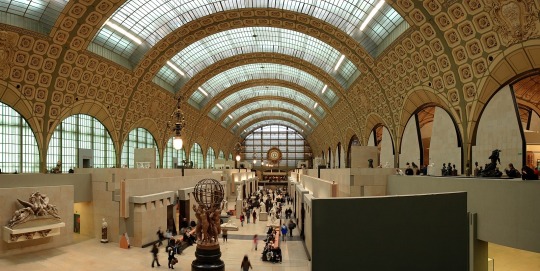
Source: Benh (2007), Main Alley Of The Musee d‘Orsay, Wikipedia, CC BY-SA 3.0 https://en.m.wikipedia.org/wiki/File:MuseeOrsay_20070324.jpg

Source: Musee d‘Orsay, Self-portrait, Vincent van Gogh, 1889, Public Domain

Source: Munch Museum, The Scream, Edvard Munch, 1893-1910, Public Domain
Travel guides usually list a variety of museums for each place that you can or even should visit - if you want to know where we come from, what is important to us or what defines us or has defined us at some point. I also strolled through one or the other museum because I saw it as part of my education. I just wanted to know and understand. It often took me to art museums - although I didn't have any real access to this "kind of art“ at the time (music, literature and movies rather touched my soul). And nowadays architecture and sculptures fascinate me even more than painting…as well of course landscapes: there is probably no more creative artist than nature itself. When visiting an art museum, it soon became customary for me to buy a museum guide to leaf through at home from time to time. There are a few museums that have stuck in my mind or that I simply like:
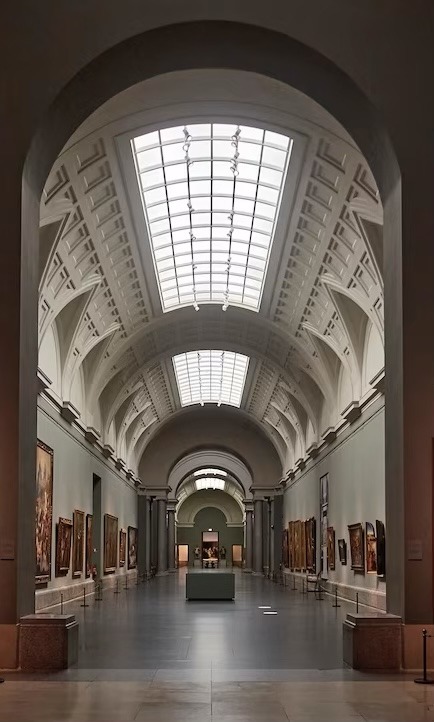
Museo Del Prado
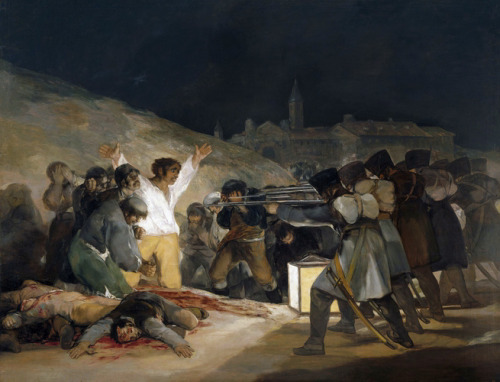
Source: Museo Del Prado, The Third of May 1808 in Madrid, Francisco de Goya, 1814, Public Domain
Musee d'Orsay (Paris): Accommodated in a beautiful old train station building, the museum contains an extensive collection of French Impressionists. Actually a "must" for everyone who likes this art epoch.
Munch Museum (the former museum in the Toyen district of Oslo): was a small, cute museum entirely devoted to the work of Edvard Munch. I was particularly impressed by the small presentation of pieces from his life - especially his first pictures from early childhood. If children of this age are still drawing stick figures, he has already drawn in perspective. So his talent showed quite early. Painters often seem to perceive the world differently than ordinary people. There is a similar presentation about van Gogh in the Van Gogh Museum in Amsterdam.
Prado (Madrid): My former school once disposed old school books - including old history books. These contained many beautiful illustrations and contemporary paintings - almost art books. I particularly liked leafing through the book about the Napoleonic Wars - because of my penchant for Napoleon. It also contained a painting by Francisco de Goya: "The Third of May 1808 in Madrid". Maybe why I often got stuck on it, because it reminded me of a scene from "War and Peace" (by Tolstoy): the shooting of alleged arsonists in Moscow. The cruelty of war: you die because you just took a wrong turn at the corner. That's why I wanted to go to the Prado in Madrid - to see this painting.
Hermitage (St. Petersburg): The museum is accommdated in the Winter Palace of the Romanovs. The building itself is a feast for the eyes - and of course the unmeasurable art treasures inside of it. We were particularly fascinated by the oversized vases made entirely of mosaics - something we had never seen before.
Roman Forum (Rome): Rome itself is actually an open-air museum - but the Roman Forum reinforces this impression. Many know the history of Rome from class, books (e.g. Colleen McCullough's series on the last years of the Roman Republic) or movies. You stroll through the streets, squares and gardens and regularly meet "old friends". You can really feel the importance and history of the place.
National Maritime Museum (London): The museum is the largest museum of maritime history in the world - a dream for anyone who is interested in that. Models of historical ships enough.
USS Constitution (Boston): A 19th-century US Navy frigate (sailing ship) - still "in service" although now only serving as a museum ship. The crew tells visitors the history of the ship in a lively and funny way, making a visit a fun affair.
Natural History Museum (London): The museum is one of the largest natural history museums in the world and is also located in a beautiful Romanesque-Byzantine building. When I visited the museum, there was a special exhibition on Charles Darwin. You could immerse in Darwin's world of ideas through carrying out experiments and by that understand his findings. This made science tangible. Incidentally, the Technical Museum in Munich follows the same approach: you understand physical phenomena by carrying out experiments (e.g. the behavior of waves at fixed or open ends).
Kennedy Space Center (Cape Canaveral): old rockets, space capsules, launch pads - a look into the history of the US space program and the preparation of current space projects. So much positive energy and enthusiasm for science and engineering. I was lucky that I was able to witness the launch of a space shuttle during my stay there (Space Shuttle Atlantis, Mission STS-86 to the Mir Space Station). A goosebump moment.

Hermitage
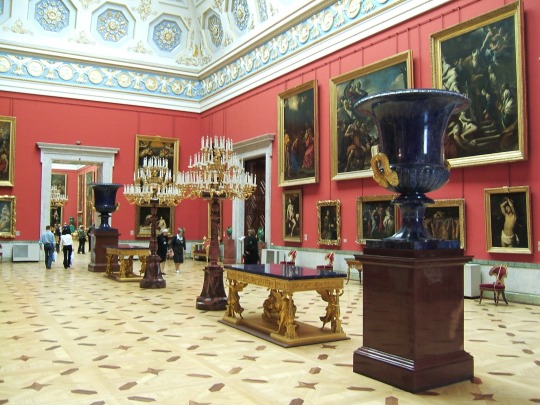
Hemitage: Oversized Vases
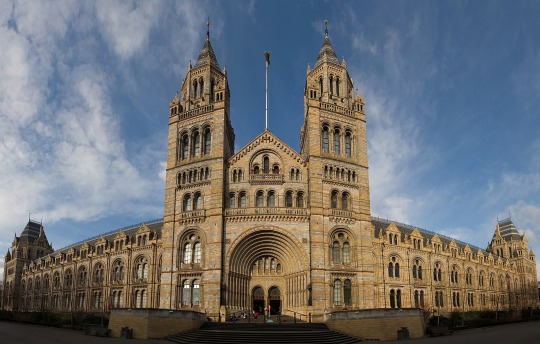
Source: Iliff, David (2006), The Natural History Museum, Wikipedia, CC BY-SA 3.0 https://en.m.wikipedia.org/wiki/File:Natural_History_Museum_London_Jan_2006.jpg
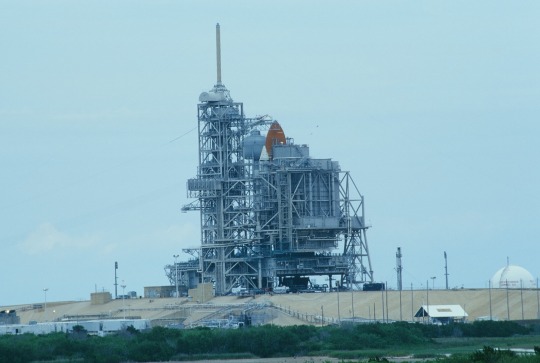
Kennedy Space Center - Launch Pad
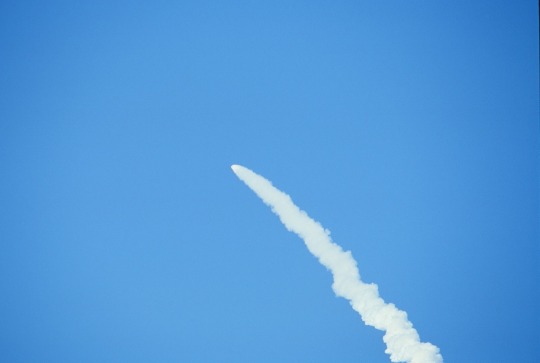
Launch of Space Shuttle Atlantis STS-86
-Simplicius Simplicissimus
#traveling#museums#musee d’orsay#munch museum#museo del prado#hermitage#eremitage#forum romanum#national maritime museum#uss constitution#natural history museum#kennedy space center#cape canaveral#art#simplicius simplicissimus
0 notes
Photo
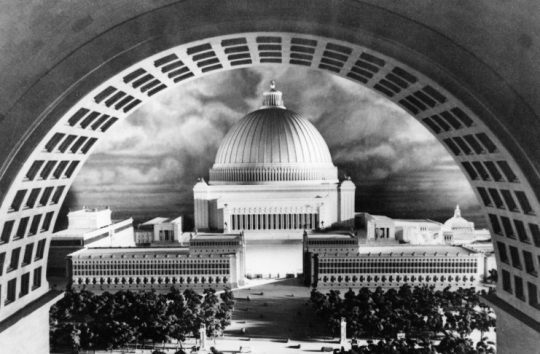
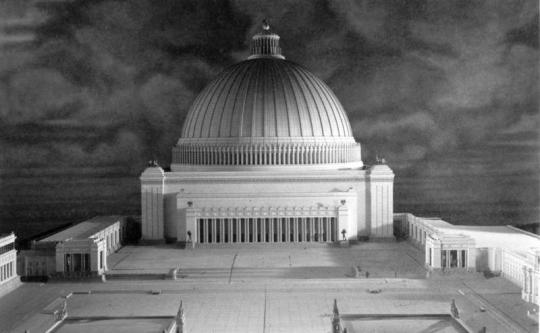
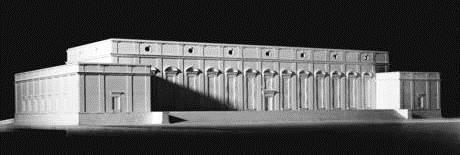
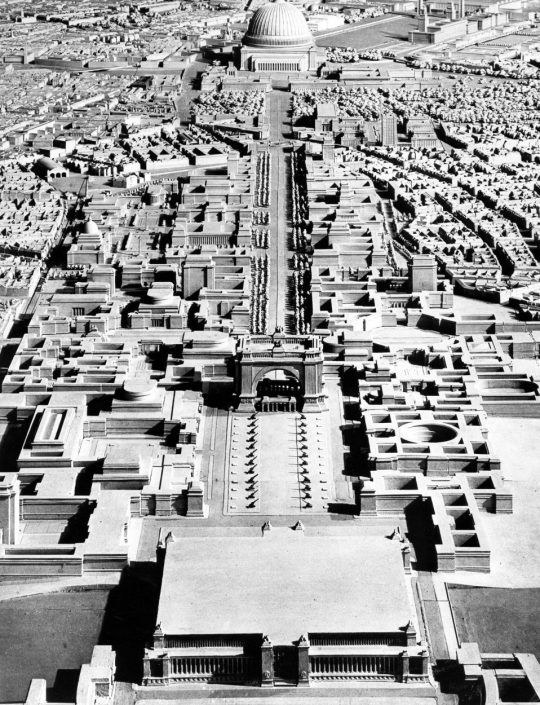
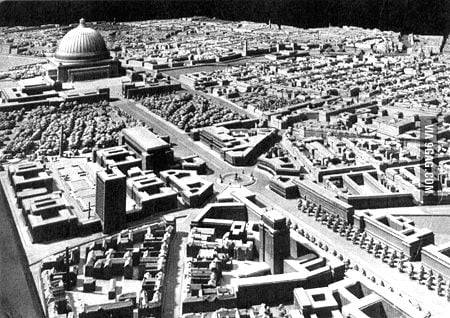
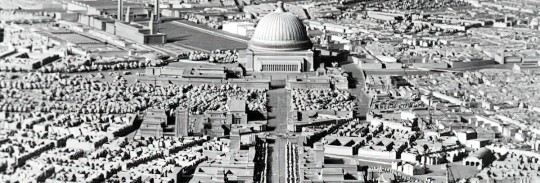

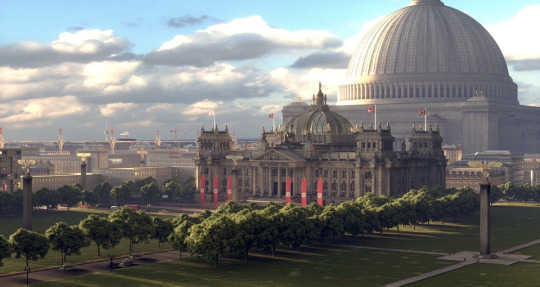
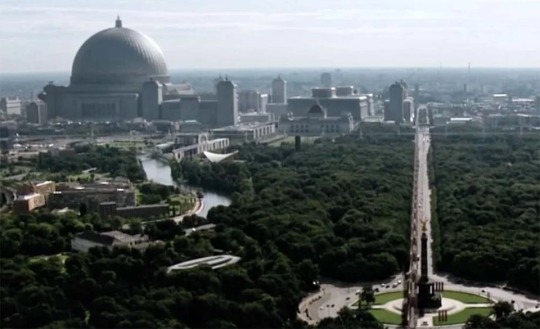
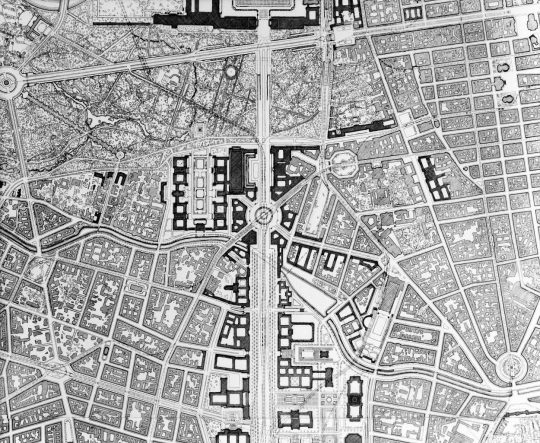
Germania – Hitler’s Megacity
Germania was Hitler’s renewal of Berlin, planned to be a megacity at the centre of his Thousand Year Reich, which started construction prior to the outbreak of WWII in 1938 until it was abandoned in 1943.
Hitler envisioned Berlin as a world capital, comparable with the achievements of the Ancient Egyptians, Romans and the Babylonians. Called the ‘Gesamtbauplan für die Reichshauptstadt’, translated as the ‘Comprehensive Construction Plan for the Reich Capital’ was intended to give the greater Germanic world empire of the New Order a capital that would instil a sense of unity amongst those of Germanic descent.
Historians suggest that Hitler first formulated plans for Germania as early as the mid 1920’s, where he drew sketches of elaborate monuments and mentions the rebuilding of German cities in his autobiographical manifesto ‘Mein Kemp’.
Hitler first proposed the concept to architect Albert Speer in the spring of 1936, an ambitious man who had risen in prominence within the Nazi Party through his architectural achievements, resulting in him being appointed to the position of ‘General Building Inspector of the Reich Capital’ (GBI) in 1937 and tasked to bring Hitler’s vision of a new Berlin to life.
Speer had already been commissioned to rebuild the Borsig Palace into offices for the new Sturmabteilung SA leadership, and would later build the enormous New Reich Chancellery which was completed in 1939 and hailed by Hitler as the “crowning glory of the greater German political empire”.
Construction of Germania began in 1938 with the razing of buildings in the Alsen and Tiergarten districts, where many Berliners were evicted from their homes and resettled in properties seized from Jewish families (resulting in many Berlin Jews being resettled in ghettos and ultimately the concentration and extermination camps).
The demand for labour led to many work camps being built near quarries, among them Gross-Rosen, Buchenwald and Mauthausen. German police rounded up what the Nazis considered ‘undesirable’, targeting homosexuals, gypsies and beggars to be worked to death in quarrying stone or baking bricks, with prisoners of war used later in the war as slave labour.
Several previous construction projects were to be incorporated into Germania, including the Tempelhof Airport, the revamped Olympic stadium, the Air Ministry, the Exhibition Hall (part of the International Convention Centre), the extended old Chancellery and the Propaganda Ministry, and the Germans Workers Front Headquarters.
Central Berlin was to be reorganised along a north-south axis boulevard known as the ‘Prachtallee’, meaning ‘Street of Splendours’, running from just west of Tempelhof Airport from the new South Station. This and an east-west boulevard would have divided central Berlin into four quadrants, where the main routes would be closed off for parades and vehicles diverted to use underground highways (parts of which still exist today).
At the northern end of the avenue on the site of the Königsplatz was a planned forum known as ‘Großer Platz’ meaning ‘Grand Plaza’. This was to be the focal centre of Germania, where on the western side was the Führer’s palace, the eastern side the Reichstag Building, and on the southern side the Reich Chancellery and high command of the German Army.
To the north of the Plaza would be the ‘Volkshalle’, meaning ‘Peoples Hall’, an enormous, monumental domed building inspired by Hadrian’s Pantheon in Rome. The temple-like nature of the domed Volkshalle was ultimately intended for public worship of Hitler and Nazi doctrine, with Speer stating in an interview after the war that “Hitler believed that as centuries passed, his huge domed assembly hall would acquire great holy significance and become a hallowed shrine as important to National Socialism as St. Peters in Rome is to Roman Catholicism. Such cultism was at the root of the entire plan.”
Towards the southern end of the avenue would be a triumphal arch based on the Arc de Triomphe in Paris, housing the names of 1,800,000 German soldiers who died during WWI. The arch was meant to erase the shame of the 1919 Treaty of Versailles, instead transforming the 1918 defeat into a victory that would mark the beginning of Germany’s rise to dominate Europe.
Doubts persisted at the time as to whether the marshy Berlin soil could hold the weight of these monumental structures, so Speer ordered the construction of the ‘Schwerbelastungskörper’ in 1941, a large concrete cylinder located at the intersection of Dudenstraße to test the ground in preparation for building the arch.
At the beginning of World War II with the German invasion of Poland in 1939, construction was suspended, but resumed after the clear German victory. The defeat of France in 1940 led to Hitler decreeing: “In the shortest possible time Berlin must be redeveloped and acquire the form that is its due through the greatness of our victory as the capital of a powerful new empire. In the completion of what is now the country’s most important architectural task I see the most significant contribution to our final victory. I expect that it will be completed by the year 1950.”
Hitler’s vision however would never be realised, setbacks during the invasion of the Soviet Union led to further construction of Germania to be permanently halted in 1943, with Berlin falling to the advancing Red Army during the Battle of Berlin in 1945.
Header Image – The Volkshalle, Germania – Image Credit : Prisma by Dukas Presseagentur GmbH – Alamy – IY02357979
#Germania – Hitler’s Megacity#adolf hitler#albert speer#berlin#nazi germany#ww2#architecture#new world order
59 notes
·
View notes
Note
Hi Lavi! I’ve just arrived in Rome for a 3 month stay! First time here so I was hoping for some local advice on things to do/see/eat :) any tips will be appreciated! P.S the ask function on the web version seems to be broken :/
hello anon! first of all sorry for replying so late yesterday I got home at like eleven something and I conked out X_X and thanks for the heads up wrt the ask, it's weird because on my web it works but I'll do a double check
that said WELCOME TO ROME I HOPE YOU DON'T END UP LOATHING YOUR STAY THANKS TO HORRID PUBLIC TRANSPORT, that said let me check because I think I had a tag exactly for stuff to do/see in rome let me see if I can give you a round up
eating advice
basic italian + advice on where to go
anyway I realized half of the posts in that tag are in italian so I'll just go at it again at random (and if you ever need advice or anything feel free to ask :D)
if you're here for three months you can take it easy and see all the stuff I mentioned in the second post with all the time in the world, also the vatican museums are free on the last sunday of the month so if you want to wake up early and brave the crowd you can save a bunch of money ;)
that said in between than the usuals - the center with coliseum/roman forum/trevi fountain/piazza del popolo/piazza venezia/campo dei fiori/piazza navona route - there's the free caravaggio paintings in the churches that I always recommend seeing asap - two are in santa maria del popolo (in piazza del popolo), three are in san luigi dei francesi (behind piazza navona), one is in sant'agostino (also near piazza navona)
also going by sculptors not counting of course sant'agnese in piazza navona (borromini) with the bernini fountain in front of it, there's san carlo alle quattro fontane (borromini) which has weird opening times but it's 100% worth visiting - that one is nearer termini station at the quattro fontane street crossing, and on the way there's also santa maria della vittoria near termini where not many ppl know there's bernini's ecstasy of st. theresa (idk every time I bring people there without telling them what it is they all go !!! omg !! XD)
always talking churches, ofc you're gonna visit st. peter's at some point (count that after covid they made it kind of harder to go in so get ready to queue), concerning basilicas I'm more partial to st. paul (there's a convenient metro station thankfully), santa maria maggiore (behind termini station) and san giovanni (there's a metro station), and in the san giovanni area (which is like in the middle of termini/coliseum) there's also san clemente which has protochristian catacombs and tunnels and is very cool to visit
talking about protochristian basilicas, sant'agnese and santa costanza are a bit out of the way but they're the earliest we have and very much worth visiting
musei capitolini are a must for archeological stuff and the roman museum next to termini is a must for ancient rome (there's also the terme di diocleziano in front of termini which are also cool)
for less commonly visited museums, centrale montemartini is v. cool because it's a former factory that houses roman artifacts
always close to termini there's rione monti which has santa prassede (lovely church with ancient mosaics) and a lot of second-hand shops/nice places to eat/have brunch
if you're interested in anthropology there's the museums in the EUR neighborhood which have a lot of cool stuff tho idk if they're still open because they were doing a renovation a while ago honestly I have no idea
when it comes to eating/going out etc go to san lorenzo for cheap drinks and nice food, it also has a lot of local flavor™ and it has my favorite surviving record shop in this city lmao
trastevere is also a must-go tho it's very gentrified these days but also very good food/drinks/brunch options, the church in the main square is a great visit and I think it's one of the few medieval-ish ones we have before baroque took hold and it's still v. good to eat, I think I mentioned a few places in the first post
idt I mentioned mr 100 tiramisù near piazza navona until now so I'll do it now because it has the best tiramisù and you can have it in 100 different variants ;)
campo dei fiori is also top notch for drinks and food also it's my favorite place in this city and camping under giordano bruno's statue is <3, also there's an independent bookshop nearby named fahrenheit 451 where you can look at a copy of said book bradbury gifted the owner and has a nice selection of stuff, they also have an english section that's not that extra but they're nice to visit
there used to be the angloamerican bookshop too for english stuff which used to be larger now they moved in a smaller place but it's still a thing, their prices are what they are but what can you do, otherwise there's some nice used english bookshops in trastevere I think in via della lungaretta but anyway if you walk through the place you'll find them fairly soon
at the piramide metro stop you'll find other than the eponymous pyramid the not-catholic cemetery which is imvho a lovely place to visit there's keats and shelley being buried there and a bunch of other famous people (italians mostly) but yeah I like going there X°D
in that spirit, right under the spanish steps there's the keats/shelley house museum dedicated to the aforementioned poets as it's the house where keats died and I haven't been in ages but it was a v good visit
in that spirit, remember to visit villa borghese AND to go to the galleria borghese museum aka one of the most important we have with prompt reminder that you need to book in advance and you only have two hours to visit so you need to time it right
in that spirit also check out the barberini musem (more caravaggio and other painters)
that said your museum priority should be the vaticans but again you have three months to see them so ;)
also go to san pietro in vincoli for michelangelo sculptures ;)
also I think I said it in one of prev. posts but for coffee go to sant'eustachio near piazza argentina it's the best
also I don't remember if I said it in the eating advice post but be kind to yourself go to the jewish quarter (always near campo dei fiori/piazza argentina) in via portico di ottavia, pick a restaurant (my favorite is the full-kosher ba ghetto it's at the beginning of the street) and try roman jewish food because it's heavenly and for the love of yourself even if you don't usually like artichokes do get jewish artichokes you'll thank me for that but again all of them are good I just think BG is superior
also in the same street if you go before 2pm there's a homerun pastry shop at the left corner of the street (it doesn't have a name but there's queues outside) where they make jewish sweets until they run out and they have excellent dark cherry pie which is to die for (in alternative there's another bakery just round the corner which has a more modern look/feel which is also great)
if you're here three months you're probably here for hannukkah and you should probably visit it then too they make special food and they have like events and such
do not ever eat in places where they give you the standard menu ie pizza/pasta + coffee + drink especially in the center that stuff is tourist trap and the food sucks you won't spend much more if you go to a normal restaurant unless it's extra fancy and you get like one dish and not two and it'll be way better
do not go up on the st. peter's dome it's a longass line and you pay and the view is meh, go to the gianicolo hill or the pincio terrace in villa borghese and your view will be better and 100% free
the public transport sucks ass like it does so expect the buses to pass whenever they like and the metros to work just if it's the A line, anyway I'd advise you to get a monthly ticket thrice so you can take buses/trains/metro/tram within the city and to download citymapper which is the most reliable app for all of the public transport here in my experience (there's probus roma as well but citymapper is more accurate as far as I've seen), also if you download one named mycicero you can buy tickets through it and have them on your phone all the time if you'd rather not get the piece of paper or go through the hassle of getting the plastic card
only take taxis if you're ready to pay a lot for it
also now that I think about it
if you wanna take a detour one day go to tivoli to see villa adriana it's amazing
you can go to castel gandolfo for the pope's summer residence which I think is now open to the public but I could be wrong
if you take the infamous train to ostia from piramide station you can go to ostia antica which is an archeological park with great roman ruins, that is if you survive the trip /s sorry that train just generally sucks but if you take it that one time it's okay XD
near the vatican there's a great japanese pastry shop named hiromi cake which if you're into that kinda sweet you might want to visit
if you shop at supermarkets todis is the most convenient, carrefour is the most pricey, coop is like most economical-but-good in between non-discounts and conad is midway, naturasi is for like natural stuff/bio things and it's pricey af (IK YOU DIDN'T ASK THAT BUT I FIND SUPERMARKET ADVICE GENERALLY USEFUL SO XD)
if you need a doctor it's free, idk how it works for foreigners staying long but in case you might need one and you aren't sorted out on that yet ask for the nearest guardia medica and they'll sort you out if you're outside, if you're at home get someone to call them and they'll arrive at your house (if you go to the hospital you might have to pay a fee but it's usually 20 euros for everything)
... okay I think I exhausted myself but if you want more info or need help or whatnot feel free to either send another ask or dm me using a throwaway if you don't want to deanon, enjoy your stay!!! <3
8 notes
·
View notes
Text
Longing for tenderness

We met Luca Marinelli on one of the hottest days of the Roman summer. And he, who has been living in Berlin for love for a year (he’s engaged to the German actress Alissa Jung), is really happy in this savannah of people who reminds him of childhood. “That warm and wonderful Rome: you go around, you experience the city at night, the walls, the streets... Mamma Roma. It's nice to be back.” In Northern Europe there is another type of energy, which comes from outside, he says. “Here it’s more complicated, you have to put yours in. But ours remains the most fascinating country in the world. It struggles, but we can still live a little more of annuity. And slowly we will wake up. I’m optimistic.” He’s not rash in his answers, he reflects, he listens to himself. You rediscover the awkwardness of the protagonist of ‘Tutti i santi giorni’ by Paolo Virzì, “I think a director won’t take you if he doesn’t see in you a piece of the character he has in mind,” he continues. “I’m very shy. If that tenderness belongs to me? I hope. I think so. I hope I'm not so clumsy, however,” he smiles. The first to believe in him was Saverio Costanzo (La solitudine dei numeri primi). Luca came from the Silvio D'Amico’s Academy and from the theater. The last, Paolo Sorrentino, who wanted him in ‘La grande bellezza’. The next film is by a newcomer, Alessandro Lunardelli, and is entitled ‘Il mondo fino in fondo’. A film on the road, shot in Chile. He and Filippo Scicchitano are two brothers who set off on a journey to discover themselves. Latin America fascinated him. “People are generous, I have met beautiful people. And every meeting serves to keep you from losing touch with life. The landscapes are crazy. Some places, certain islets, are so wild that no one has ever set foot there”.

His father was a voice actor. And this certainly has to do with his decision to become an actor. But even more the feeling he got when, as a child, so shy, he was able to entertain people: “At that moment I felt I had a task. A particular strength. That's what I found in the theater. Before going on stage there is terror. Then you think, "I'm here. I know what to do." And there is only the desire to tell, to involve others, to make them feel good, to get excited... You need the applause of the audience. You try to look at a big face but sometimes something catches your attention. There is the one who laughs, the one who sleeps...
"I like reading adventure books, going around the city, doing simple things: staying. With calmness and a smile"
The important thing is not to be discouraged.”
If he were to explain his work to a child he would say to him: “I am an actor because it’s a profession where, even if you are old, you have permission to play. And it's a very serious game, like the ones you play...”
A job that continues to surprise him. “In my opinion, not even the consummate actors go straight and decisive on a track. It’s a continuous search, discards left and right…”

THE GERMAN GIRLFRIEND
At school he "studied enough". He reflects. “It’s a mortal sin that hardly anyone goes to school with joy.” He says it in an attentive tone, articulating the words well. “My heroes? I liked history. I remember a class trip to the Roman Forum: I gasped in front of a trio, carved in the stone of a step. I stood there, enchanted, imagining the ancient Romans playing tic-tac-toe.” In Berlin, they like to go to the Mauerpark on Sundays. In the afternoon there is a flea market and karaoke in the evening: “A guy arrives on a bicycle with two giant boxes in front of an amphitheater, with huge steps, which slowly fills up. There is a very long list, if you manage to perform it is exciting: there are two thousand people listening to you in a crazy setting.”
After ‘Waves’, a film shot on the sea, he became passionate about boating, the names of winds, adventure books and now is reading Robinson Crusoe. His main occupation when he isn’t working is: going around the city. “Do simple things: stay. With calm and a smile.” He doesn't like rudeness, abuse. “Oh my God, now I look like Jesus.” But there is little to joke: it’s on the set of ‘Maria di Nazareth’ by Giacomo Campiotti that Luca, playing Giuseppe, fell in love with Alissa (Maria), a popular 32-year-old German actress, single mother of two children. Shyness arises when you ask him if he wanted children of his own (-Yes, but later-) or what he looks for in a woman, in a story: “What is the answer in these cases? I’m not prepared.”
A thousand meetings with the public after a film screening rather than a vaguely intimate question. Then he thinks about it. “The best thing you can do is never forget to smile. To thin the clouds of the other, without making it a burden for them. Take her sack on your shoulder, carry it for her. Life is difficult if you get lost in thoughts. If you can blow them away, instead... The smile gives me so much strength.”
ELLE
Just wanted to translate this old interview for the non-italian’s fans ^^ (sorry for my English)
301 notes
·
View notes